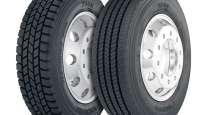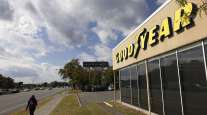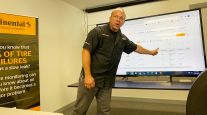Low Rolling Resistance Tires Gain Traction With Carriers Seeking to Save Fuel, Money
This story appears in the June 20 print edition of Transport Topics.
The recent rise in diesel prices has given trucking companies a greater incentive to search for ways to cut fuel costs, according to carrier and tire manufacturer executives. One answer that is gaining acceptance is the use of low rolling resistance tires (LRRs) — which are touted by the federal government’s SmartWay Transport Partnership program.
Penns Best Inc., a truckload carrier based in Meshoppen, Pa., is taking that advice. The carrier is in the process of converting its fleet to LRR tires.
“We’re relying heavily on what SmartWay is telling us will help — and we’re trying them,” said Patrick Healey, president of Penns Best.
According to SmartWay’s website, specifying tires with low rolling resistance on a combination truck can provide immediate fuel savings.
“Low rolling resistance tires do save fuel,” said Jimmy Ray, co-owner of Mesilla Valley Transportation, Las Cruces, N.M., which uses LRRs made by Michelin North America, Greenville, S.C. “We are using only fuel-efficient tires in all positions . . . [and they] have always met the fuel-mileage expectation that Michelin advertises.”
Ray said Mesilla Valley has been using LRRs since around the turn of the century.
“They do help [improve fuel mileage] considerably,” said Roger Stansbie, director of radial truck tire engineering for Continental Tire the Americas, Fort Mill, S.C., which manufactures the LRR tires that Penns Best is putting into service.
Penns Best started switching to low rolling resistance tires a little more than three years ago, and now is halfway through the conversion, Healey said. The carrier operates 75 company-owned tractors and contracts 35 owner-operators. It runs about 575 trailers.
When the carrier orders new equipment, it orders the tires for the OEM.
“We just bought 50 new trailers, and we provided the 400 [LRR] tires to the manufacturer to keep our tires consistent,” Healey said.
Penns Best has about 1,800 of the tires in service now, said Bob Carney, purchasing manager. Carney estimated that they cost the fleet an average $20 to $30 more than the carrier had been paying for tires.
Carney also said the new tires are wearing on a par with their predecessors — and in some cases better. He credited the carrier’s tire dealer, McCarthy Tire Group, Wilkes-Barre, Pa., with helping phase in the tires.
But, Carney said, what cannot be clearly assessed is the tires’ contribution to fuel savings. That will have to wait until the fleet is completely converted, he said, because the tires are one of many fuel-saving measures Penns Best has taken.
For example, the carrier has adopted more equipment with aerodynamic features, auxiliary power units and an automatic shutdown feature to reduce idle time. In addition, it is spec’ing an automatic transmission and has adjusted its governors to lower speed limits — 67 mph on cruise control and 65 mph on the pedal.
Amid all of those steps, Carney said, they haven’t yet been able to assess the effect of the low rolling resistance tires.
“In order to see the full savings, the steers, drive and trailer [tires] all have to be SmartWay-approved tires, and we’re just not there,” he said.
To generate more savings, Penns Best said it would like to be able to recap the 50 or 60 low rolling resistance casings it has stockpiled in a shed. Unfortunately, there is no SmartWay certification for retread LRRs.
“They were drive tires that ran 300,000 miles,” Carney said, “and I don’t want to recap them because we’re waiting for one of the retread manufacturers to come out with a SmartWay-approved cap.”
The SmartWay Transport Partnership was set up in 2004 by the U.S. Environmental Protection Agency. It verifies for businesses and consumers products and services that reduce emissions, sometimes by decreasing fuel consumption. Verified products and services, including low rolling resistance tires, are listed on the SmartWay website.
Goodyear Commercial Tire Systems, Akron, Ohio, recently introduced a SmartWay-approved reduced rolling resistance tire with deeper-than-normal treads for a normal LRR (6-13, p.14). Other tire manufacturers that make SmartWay-verified LRRs are: BF Goodrich, Greenville, S.C.; Bridgestone Americas, Nashville, Tenn.; Dunlop Tires, Sherman Oaks, Calif.; Firestone Inc., New York; General Tire, Fort Mill, S.C.; and Yokohama Tire Corp., Fullerton, Calif.
Resistance to rolling occurs in tires when a vehicle moves. The tires flex, absorbing energy and generating heat. The more a tire heats up, the more energy it retains — energy that otherwise would be used to propel the truck, Continental’s Stansbie said.
“Rolling resistance can be measured simply in Btu of heat,” Mesilla Valley’s Ray said. “Anything that makes heat takes horsepower to run. Low rolling resistance tires create less heat.”
Don Baldwin, product category manager for commercial truck tires for Michelin, said about one third of every tank of fuel is used to overcome the normal rolling resistance of tires.
Besides MVT, Baldwin said Con-way Truckload, Joplin, Mo.; Spirit Truck Lines, San Juan, Texas; and U.S. Xpress Enterprises, Chattanooga, Tenn., also use low rolling resistance tires made by Michelin.
Tire manufacturers said they focus primarily on compounds and tread design to lower rolling resistance.
Certain compounds can help limit the amount of energy and heat that end up trapped in tires, Stansbie said.
“Rubber will naturally try to retain energy unless it’s persuaded differently,” he said.
To persuade tires to act differently, manufacturers tinker with the mixture of synthetic and natural rubber, as well as the carbon black used for reinforcement, to address energy absorption, Stansbie said.
Tread design is another major influence.
Features such as lugs (tires with thick, wide treads) and sipes (small slots that are cut or molded into a tire tread with the purpose of increasing traction) contribute to rolling resistance, Stansbie said.
“A smooth tire is probably more fuel-efficient than a multi-groove tire — with all other factors equal,” he said.
But grooves are needed to absorb or channel water and allow the rubber to make contact with the road surface. “So there’s a trade-off,” Stansbie said, in arriving at a rib-lug combination that provides traction and better mileage.
Stansbie said Knight Transportation and Swift Transportation, both based in Phoenix, are among carriers that use low rolling resistance tires made by Continental.
One of the ways tire makers lower rolling resistance is by lowering the tread depth, manufacturers said.
Another option to achieve lower rolling resistance is wide-base tires, or “super singles,” SmartWay and tire manufacturers said.
“If you can replace a set of duals with a single tire you reduce the number of sidewalls and beads so you inherently get lower rolling resistance, generating less heat [and] losing less energy in the rolling process,” Michelin’s Baldwin said. Michelin’s X One wide-base tire is SmartWay verified.
The North American Council on Freight Efficiency, in a report issued in December, said that the lower rolling resistance of a wide-base tire yields “immediate fuel use improvement of 3% to 6%.”
“They are intrinsically better for rolling resistance than combinations of dual tires,” Continental’s Stansbie said. “The mere fact that you’ve got one tire, compared to two tires in combination, is a big factor in favor of [lower] rolling resistance.”
C.R. England Trucking, Salt Lake City, started spec’ing Michelin low rolling resistance, wide-base tires on new tractors last fall, said Todd England, executive vice president for maintenance.
The carrier decided to make the switch after conducting tests that showed the tires delivered a fuel savings, he said. Between 500 and 600 tractors, about 20% of the carrier’s power units, are now operating with the tires. It will be another three to four years before all tractors are fitted with the tires, England said.
“We have used wide-base Michelin tires since 2001,” MVT’s Ray said, adding that only the company’s steer tires are not wide-base.
“A wide-base tire has less rolling tread and two less sidewalls to flex,” he said.
In addition, Ray said: “The wide-base tire is never mismatched in circumference and the air pressure never creates an unbalanced pressure to match its dual wheel tire mate.”
For further improvements in fuel efficiency, tire manufacturers continue to focus on coming up with compounds that can help reduce energy absorption, so that tires retain less heat and generate lower rolling resistance, Stansbie said.
Further changes in tread design, such as reducing grooves and lugs can help, too. But, Stansbie said, “Maybe that’s going to be a hard one” to sell, especially when it comes to drive tires.
He said drivers tend to equate a more aggressive-looking tread with more traction, which is “not necessarily true in reality.”
“When we get to more circumferential grooved tires in pursuit of lower rolling resistance, it may mean more educational processes [will be needed] for the user to accept a less obvious tractive appearance.” Stansbie said.




